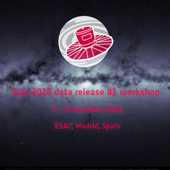ESA Science & Technology - News Archive
News archive
News archive
The CHEOPS Consortium is inviting proposals from scientists to join the CHEOPS Science Team as CHEOPS Science Team Associate members (CSTA). Closing date for proposals: 1 March 2017
Published: 26 January 2017
By using galaxies as giant gravitational lenses, an international group of astronomers using the NASA/ESA Hubble Space Telescope have made an independent measurement of how fast the Universe is expanding.
Published: 26 January 2017
The sheer observing power of the NASA/ESA Hubble Space Telescope is rarely better illustrated than in an image such as this. This glowing pink nebula, named NGC 248, is located in the Small Magellanic Cloud, just under 200 000 light-years away and yet can still be seen in great detail.
Published: 20 December 2016
An extraordinarily brilliant point of light seen in a distant galaxy, and dubbed ASASSN-15lh, was thought to be the brightest supernova ever seen. But new observations from several observatories, including the NASA/ESA Hubble Space Telescope, have now cast doubt on this classification.
Published: 12 December 2016
New observations from the NASA/ESA Hubble Space Telescope have revealed the intricate structure of the galaxy NGC 4696 in greater detail than ever before. The elliptical galaxy is a beautiful cosmic oddity with a bright core wrapped in system of dark, swirling, thread-like filaments.
Published: 1 December 2016
On 2-4 November, the European Space Astronomy Centre near Madrid, Spain, will host the Gaia 2016 Data Release #1 Workshop. Many of the talks will be broadcast live.
Published: 28 October 2016
While scanning the sky to measure the position of over one billion stars in our Galaxy, ESA's Gaia satellite has detected two rare instances of stars whose light was temporarily boosted by other celestial objects passing across their lines of sight.
Published: 27 October 2016
Astronomers using data from the NASA/ESA Hubble Space Telescopes and other telescopes have performed an accurate census of the number of galaxies in the Universe. The group came to the surprising conclusion that there are at least 10 times as many galaxies in the observable Universe as previously thought.
Published: 13 October 2016
ESA's ambitious Gaia mission is the culmination of over two thousand years of astrometry – the science of charting the sky. A new sonification demonstrates in a novel way the remarkable progress that has been made in the lead up to the first data release from Gaia.
Published: 22 September 2016
A distant planet orbiting two stars, found by its warping of spacetime, has been confirmed using observations from the NASA/ESA Hubble Space Telescope.
Published: 22 September 2016
The first catalogue of more than a billion stars from ESA's Gaia satellite was published today – the largest all-sky survey of celestial objects to date.
Published: 14 September 2016
An international team of astronomers using Hubble have been able to study stellar evolution in real time. Over a period of 30 years dramatic increases in the temperature of the star SAO 244567 have been observed. Now the star is cooling again, having been reborn into an earlier phase of stellar evolution. This makes it the first reborn star to...
Published: 13 September 2016
A fossilised remnant of the early Milky Way harbouring stars of hugely different ages has been revealed by an international team of astronomers. This stellar system resembles a globular cluster, but is like no other cluster known.
Published: 7 September 2016
Media representatives are invited to a briefing on the first data release of ESA's Gaia mission, an astrometry mission to map the stars of our galaxy, the Milky Way. The media briefing is being organised at ESAC, in Spain, on Wednesday 14 September 2016, 11:30-13:00 CEST.
Published: 1 September 2016
ESA's Planck satellite has revealed that the first stars in the Universe started forming later than previous observations of the Cosmic Microwave Background indicated. This new analysis also shows that these stars were the only sources needed to account for reionising atoms in the cosmos, having completed half of this process when the Universe...
Published: 31 August 2016
A giant bubble surrounding the centre of the Milky Way shows that six million years ago our Galaxy's supermassive black hole was ablaze with furious energy. It also shines a light on the hiding place of the Galaxy's so-called 'missing' matter.
Published: 29 August 2016
Since its launch in December 2013 Gaia has been sweeping the skies mapping around one billion stars. The data collected will allow astronomers to probe the very nature of the astronomical objects observed by the spacecraft. But before the data can be useful to the scientific community they must pass through a complex and robust processing...
Published: 24 August 2016
Proposals are solicited for observations with XMM-Newton in response to the sixteenth Announcement of Opportunity, AO-16, issued 23 August 2016. This AO covers the period May 2017 to April 2018 and is open to proposers from all over the world. The deadline for proposals is 7 October 2016 (12:00 UT).
Published: 23 August 2016
Operating in the depths of space, far beyond the Moon's orbit, ESA's Gaia spacecraft has now completed two years of a planned five-year survey of the sky. Despite a series of unexpected technical challenges, the mission is on track to complete the most detailed and complex mapping of the heavens ever undertaken.
Published: 16 August 2016
Astronomers using the NASA/ESA Hubble Space Telescope, along with other telescopes on the ground and in space, have discovered the system AR Scorpii to be a new type of exotic binary star.
Published: 27 July 2016
—
20 Items per Page




















